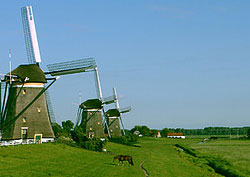Dutch Windmills
 Why
Dutch windmills
are special
Why
Dutch windmills
are specialMany countries have windmills, but Holland (The Netherlands) has the greatest concentration and the most picturesque structures. And they have become an integral part of the Dutch heritage.
Dutch windmills tips and insights
Uses
Windmills pump water out of the reclaimed and being-reclaimed farmlands. They also perform functions like grinding wheat grains into flour, crushing mustard seed into mustard, and sawing trees into lumber.
Count
10,000 once stood. Then came the 19th-century Industrial Revolution. Engines could do the pumping, grinding, sawing, among other tasks less expensively and more efficiently.
Today, only about 1,000 Dutch windmills remain. Some are operational, but most are kept for historical and tourism values.
Size
Some of the windmills reach as high as a modern 7-story building.
How they work
Windmills are more complicated than they might seem from the outside. In simplified terms, wind energy revolves the windmill's blades (sails), which rotates a tall central shaft, which transfers its motion to a set of gears, which powers the pumping, grinding, whatever tool apparatus that does the intended job.
Best sightseeing site
The small village of Kinderdijk (under a half-hour drive from Rotterdam) has 19 windmills. They are on average about several centuries old and are in good condition. Because these windmills sit relatively close together, they give you an excellent photo op.
Related web pages
Windmills are one of the three key flood management elements. Click Dutch Canals and Dutch Dikes to read my web pages on those two wonders.


